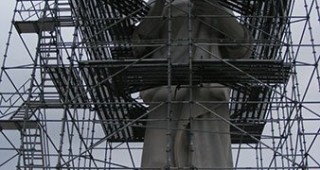We climb the stairs to the first floor and enter a room where the different Havana Club rums are exhibited, as well as a sample of the tools used in the 19th century for cultivating sugarcane and producing molasses. There is a collage of images of African slaves, who were the principal workforce until the mid-19th century, at work in the fields. While we look at exhibits, our guide explains how Columbus first brought sugarcane stalks from the Canary Islands during his second trip to the Americas, initially to Hispaniola (today’s Dominican Republic and Haiti) and then to other regions in the Americas. Sugarcane easily adapted to Cuba’s climate and soil and acquired a unique aroma that distinguishes it from other sugarcane grown in other places making it the prime and irreplaceable material in rum making.
The second part of our tour shows the actual production process of Havana Club Rum thanks to an amazing tiny sugar mill designed according to the typical mills of the 20th century, with fermentation tanks and distillation area where aguardiente, the distilled spirit of sugarcane, is obtained, and the half lighted warehouse where rum and aguardiente are aged under the zealous care of master rum makers. After an 18-month period of aging, they are blended with treated water and pure spirits producing a young rum which is filtered and bottled as Silver Dry (White Rum). Or it is aged some more in white cedar wood barrels that are scraped and burnt, acquiring special characteristics that are impregnated in the future rum during aging. The longer the rum is kept in the barrels, the darker it becomes. And its taste also changes, but it is not until when the blend is made that rum becomes rum. It is then that master rum makers combine different types and ages to obtain the desired product.
We walk down the stairs on the other side of the museum down to a narrow bar with an exhibition of different rum labels, stones used for their printing, and other artefacts related to the world of rum. Our guide offers us a shot of Havana Club 7 Años. It is a preamble to sampling (professional research) some more produce in the Havana Club Bar. I am tempted by the “ultra-premium extra-aged” exclusive Máximo Extra Añejo, (bottled in Murano glass with gold inlays) but settle for a mojito in the 1930s style place which has filled up since I came in. A traditional band—Guaravana Song—plays Cuban son. Time passes, not such a bad life…
Museo del Ron
Ave. del Puerto #262, esq. a Sol, Habana Vieja
(+53) 7-862-4108 / 862-3832 / 861-8051
Open Mon-Thurs, 9:00am to 5:30pm
Fri-Sun, 9:00am to 4:30pm
Tours in Spanish, English, French, German and Italian
Price CUC 7




 Post 1959
Post 1959






